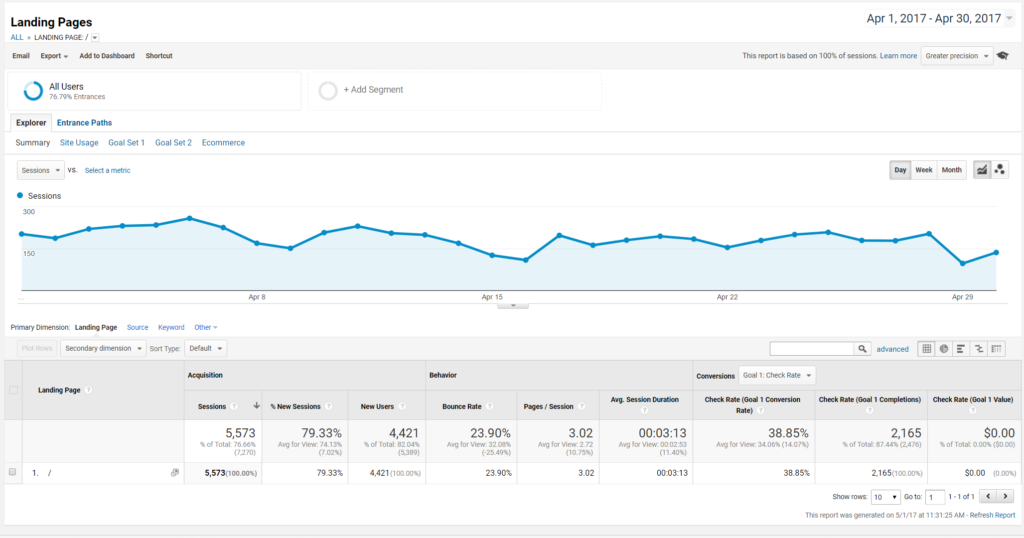If you want your hotel’s website to appear in search results, it is vital to have a plan on what content you are publishing, when you will publish it, and how you will make sure both users and search engines will find it. Whether this content is on a brand new webpage, or if this is an existing page in need of a refresh, your strategy towards developing and promoting this content will ultimately determine its success.
By creating a roadmap for your content you can easily figure out your next page topic and also predict and track how successful it is and extend your plan to future pages and your overall marketing strategy.
“What is a content roadmap?” Your content roadmap is a breakdown of how your site currently performs, how you want it to perform, and the steps you will take to achieve that goal. Your goal can range from increasing your number of visitors by a certain amount in three months, earning 30% more conversions in a year, or ranking on page 1 for a particular keyword in six months. So long as the goal you lay out is measurable and within reach, you can lay out what steps you will need to take and when to take them.
Step One: Benchmark Your Current Performance
Before you start thinking about how well you want your website to perform, you need to know how well it currently performs. If you were on a trip and using a roadmap, it would be pretty useless if you could not find out where you were in the first place. The knowledge you gain here will allow you to figure out where your website is strongest and weakest, and you can make an informed decision on your goals and strategy.
To kick off this journey you will want to explore the data tracked on your website to discover where it is performing well and poorly, while also thinking creatively about your website to determine opportunities and threats, commonly called a “SWOT analysis.”
Whether you are using a document or writing it out on a piece of paper, box off four sections and start putting notes into each one. What are you impressed by with your sites performance (strengths)? What disappoints you (weaknesses)? Is there something you have not done, or an important event coming up that you can use to your advantage (opportunities)? Is there an upcoming trend or event that might hold your site back (threat)? Take each answer and write it down in its corresponding place, whatever your goal ends up being it should involve expanding your list of strengths, eliminating weaknesses, capitalizing on opportunities, and preparing for threats.
Open up the Google Analytics dashboard for your website (assuming you have Analytics implemented) and start exploring. Which pages are seeing the most traffic? Which pages see the least? Where do you see the most conversions? You can find all this information and more details about user behavior through Google Analytics, and these metrics will be highly valuable to add to the analysis of your website. The more thoroughly you dig, you will discover various items on your site to be proud of and new ones that need more work.
Analytics is not your only ally in this battle. Google Search Console can also be added to your website, and features a Search Analytics dashboard that is a boon for any SEO Manager. Search Console allows you to view how your site has performed in search for the last 90 days, helping you learn what pages are ranking well, what terms they are ranking for, and how many clicks they are getting. There are many other uses for Google Search Console besides this feature, however we will stick to just Search Analytics in this post. You can break down the data Search Console provides by individual pages, or your site as a whole, along with a few other options, leading to countless combinations of data presentation to show you how you are performing in search.
In your SWOT analysis as well as another document, start taking the metrics important to you and copy them down – you will use this in the future to determine your success. Look at quantifiable data such as the number of users landing on a page over a certain date range, how many times a link was clicked, or the percentage of users who left the page without interacting with it. You should be making careful notes about various metrics across your website and the date ranges they cover. As you enter this data into your SWOT, consider a few important questions. What strengths do you want to maintain or improve, what weaknesses do you want to eliminate, is there a major opportunity you can take advantage of, and what threats are looming on the horizon?
Choose from this overview what you want to accomplish over a certain time period. The more often you create and execute a roadmap, the more skilled you will become at selecting the best goal and constructing a reasonable timeframe.
Step Two: What Steps Will Help You Reach This Goal?
You know how your website performs, and how you would like it to improve, now it is time to determine what steps will take you there. Depending on what goal you have set out, you will need to conduct different actions in order to reach them.
For example, if you want to improve on your keyword rankings, you will want to conduct thorough keyword research, and work on the written copy on your site in order to make it appear as relevant as possible for the keywords you wish to target.
Tip: Do not just pick the highest volume keyword, or a phrase you like, and try and rank for it, take the existing search volume and your rankings for each keyword you discover into account and consider the likelihood that you will rank on page one based on how your site compares to those appearing in SERP.
Perhaps you are more interested in boosting your conversion rate, and generating more room visits from the users that are already finding your site. When this is the case, you should focus on the sales funnel reflected by your website, and make sure you provide the ideal user experience.
Tip: Make a point to track every possible action through Google Analytics and monitor how users are moving throughout your website. The more data you have on what actions users are taking, the more successful you will be in achieving your goals.
If you want to generate more users to your website, look at your Metadata and how you appear on SERP. Are there any highly relevant keywords you should be ranking for? How else are you promoting your site to encourage users to visit?
Tip: Social media can be your best friend when it comes to promoting your website. Find ways to share your new content to help generate traffic and engage with potential guests!
No matter what your goal is for the success of your website, the two areas that will always improve how it performs is the quality of content and the links pointing to your site. Always be on the lookout for new and exciting opportunities for interesting content that is missing from search results, and connect with authoritative websites to generate links that will increase your authority and provide visits.
Tip: Not all links you can build to your site are inherently good. Avoid spammy directories and link exchange sites to maintain a profile of high quality links directing users and search engines to your site. Google has very clear guidelines on what constitutes a link scheme and it is always wise to follow their quality guidelines.
Putting Your Data and Goals into Practice
Take a look at the steps you need to follow and set yourself up with a schedule and a timeline towards when to have them done. Make sure that the strategy you will be following in your roadmap makes logical sense and will yield the most success.
Perhaps you run a hotel in Downtown Chicago that has just completed a major renovation. Because of the construction you have had fewer booked room nights, and users have been leaving your website after seeing your page about renovations. However, tourism in the area is about to skyrocket due to a major event in the area. You want to boost your occupancy by 50% over the next three months. What do you do?
Before you begin pull as much data as you can from your website and your revenue data from the same timeframe so you have a benchmark to work with at the end of your campaign. Look at your lowest performing pages and analyze what the cause might be.
Next, you need to update your website to show that renovations are complete and improve on your low performance pages, refresh them with bold new photography to show off your modern style and target the keywords you are currently ranking well for in your on-site copy. Make sure your pages are funneling users in a way that show off your new style and verify that the user experience you provide is going to improve your number of conversions by effectively selling your rooms.
If you have the time to conduct keyword research and write on an upcoming event near you. Write a landing page about it and promote it on and off your site to help attract visitors coming in for the event.
Now that the overall health of your website has improved it is time to generate some traffic to it. Promote your completed renovations on social media and engage with local events and businesses that will generate tourism to help build up qualified traffic. If possible, reach out to websites for events and businesses in the area with an accommodations page to include your hotel as a recommended option!
One important final part of your SEO content roadmap is this is not a Ron Popeil ad, you cannot just set it and forget it…
Step Three: Tracking Progress and Making Adjustments
As you follow the roadmap you have laid out you will want to track and monitor the results of every change you made from your first benchmarks. Periodically look at the data and compare how you are currently performing to how you were at the beginning and make note of any major changes.
It is entirely possible that you will not be 100% on track for your goals at some point or another. Being able to adapt your plan as you follow the roadmap is key to making your website as successful as possible. As you make changes and track results, you will begin to understand how and why certain changes have certain effects. Over time, when you begin future campaigns with new goals, you will be more skilled and capable of achieving newer and more ambitious objectives!
From Content Roadmaps to Full SEO Campaigns
It is entirely possible that after looking over your website data you will find your needs are far too great for a single update of planned out content. What you might need is a full scale, integrated campaign featuring SEO efforts across your site, social media, and even paid search. Content roadmaps are great for reaching a singular goal but campaigns are what can help secure the long-term success of your hotel. Get in touch with the Blue Magnet team to learn how we can take your hotel’s digital marketing efforts to the next level!
Stay tuned for more updates from Blue Magnet’s Front Desk SEO series.







